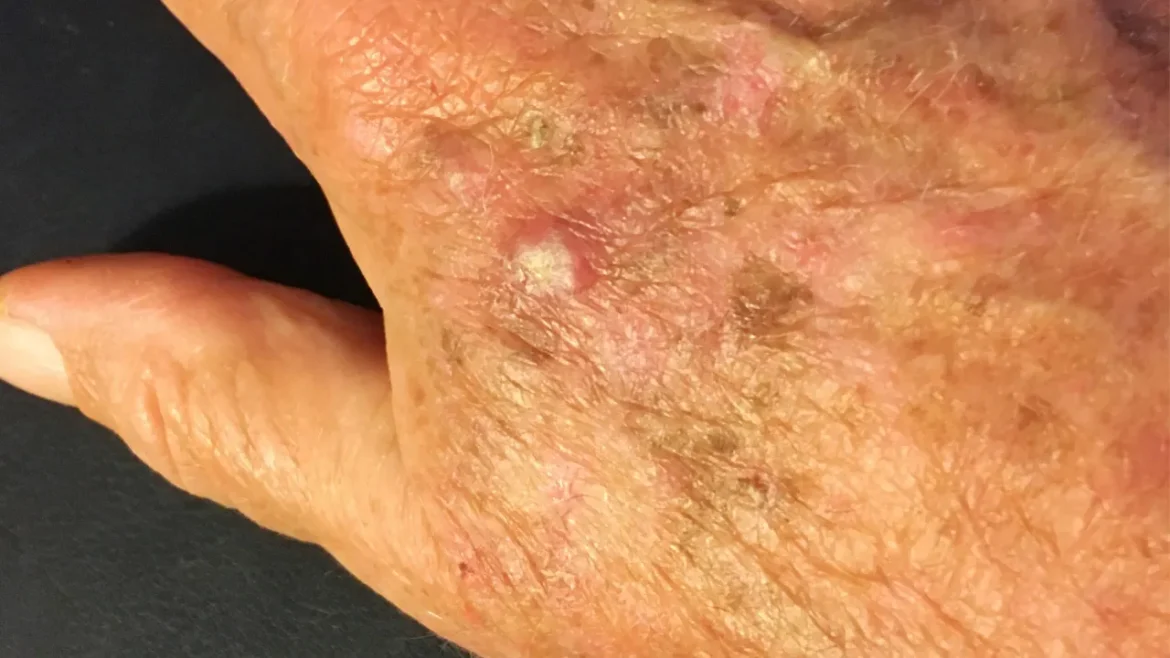Description
Actinic Keratosis is a prevalent skin condition that mainly affects adults over the age of 40. It is possible for both men and women to develop Actinic Keratosis, although those with fair skin tones, light-colored hair, and eyes that are either green or blue are more prone to do so. Lesions usually appear after extensive sun exposure on the skin of the face and neck, the scalp, and the arms, among other body parts where the lesions may appear.
The first sign of Actinic Keratosis is typically the emergence of a small, slightly elevated, rough, and scaly area on the skin. Such patches can be skin-colored, brown, or red, and they can get as big as a few centimeters in size. The patch might thicken and take on a tough, horn-like feel with time. The patch might transform into an ulcer or squamous cell carcinoma, a kind of skin issue that could develop into cancer if neglected.
You May Also Like:
CBD CONTRACT MANUFACTURER –TOP 5 BEST IN CLASS FOR 2022
KRIA BOTANICALS VS PARTNERED PROCESS: TWO CBD CONTRACT MANUFACTURERS COMPARED
Actinic Keratosis: Description, Causes, and Treatment Protocol is an original (HealthXWire) article.
Possible Causes
Long-term sun exposure or long-term use of indoor tanning beds are the primary causes of Actinic Keratosis. The DNA in cells of the skin is harmed by UV radiation, which promotes the creation of aberrant growths like Actinic Keratosis. The chance of acquiring Actinic Keratosis increases due to age-related declines in skin repair capacity.
A compromised immune system, exposure to specific chemicals or substances, and a history of skin damage or inflammation are some additional factors that may play a role in the development of Actinic Keratosis. Because their immune systems are compromised, individuals who have had organ transplants or are taking immunosuppressive medications are more likely to develop Actinic Keratosis. Actinic Keratosis risk can also rise with exposure to specific substances like arsenic. Actinic Keratosis risk can also be increased by skin damage or inflammation, such as that brought on by burns or infections.
Exacerbating and Mitigating Factors
There are several factors that can exacerbate or mitigate the development of Actinic Keratosis. Some of the exacerbating factors include:
Sun exposure: Actinic Keratosis is mainly brought on by persistent sun exposure. As a result, it’s crucial for you to avoid spending too much time in the sun, particularly in the summer.
Tanning: Actinic Keratosis may form as a result of the UV radiation that tanning beds release. Staying away from tanning beds seems a crucial step in reducing your risk of getting this ailment.
Genetics: Actinic Keratosis may run in some families and be inherited.
Age: As the skin’s capacity for self-repair declines with age, the risk of acquiring Actinic Keratosis rises.
On the contrary, a number of mitigating variables can aid in lowering the likelihood of acquiring Actinic Keratosis that involve:
Sun protection: Actinic Keratosis can be prevented by wearing protective clothing like long sleeves and helmets and by using sunscreen having a high SPF.
Healthy lifestyle choices: Actinic Keratosis might be prevented by maintaining a nutritious diet, getting regular exercise, and abstaining from tobacco and alcohol usage.
Avoiding tanning beds: As was previously noted, tanning beds generate UV radiation that may raise the probability of Actinic Keratosis.
Regular skin exams: Regular skin examinations can aid in the early detection of Actinic Keratosis, during which it is most curable.

Standard Treatment Protocols
The following options for treatment are frequently included in the standard Actinic Keratosis treatment regimen:
Topical Medications: The application of topical medicines constitutes one of the most widely used therapies for Actinic Keratosis. These drugs function by destroying the aberrant cells when administered directly to the afflicted region. The most typical topical treatments for Actinic Keratosis are comprised of the following:
Fluorouracil (5-FU): The aberrant cells die and get separated after a few weeks of treatment with this medicine on the affected region. During therapy, it may trigger a lot of irritation to the skin along with redness.
Diclofenac (Solaraze): Nonsteroidal anti-inflammatory drugs (NSAIDs) are used to treat an affected region with this medicine. Diclofenac decreases inflammation and helps the human body get rid of unwanted cells.
Imiquimod (Aldara): This medicine helps the immune system become more adept at identifying and eliminating aberrant cells. Several weeks of application to the afflicted region can result in inflammation and redness.
Curettage and electrodessication: Utilizing a curette, the region that is affected is removed, and any abnormal cells that remain are then destroyed employing an electric current. Despite the possibility of scarring, this treatment may be helpful.
Photodynamic Therapy (PDT): The afflicted region is treated with a photosensitizing chemical, which is subsequently exposed to light to trigger the destruction of aberrant cells. PDT should be avoided in the sun after treatment since it might produce redness and edema.
Cryotherapy: In order to kill aberrant cells, this therapy includes freezing the affected region with liquid nitrogen. Although quick and efficient, cryotherapy can be uncomfortable and may call for multiple sessions.


Treatment Options
Natural Remedies: Although a few natural treatment options for Actinic Keratosis may be helpful as supplemental treatments, they are not suggested as a substitute for standard medical care. These therapies are:
- Aloe vera
The anti-inflammatory qualities of aloe vera can potentially alleviate the redness and inflammation brought on by Actinic Keratosis. The afflicted region can be treated topically with aloe vera gel.
- Green tea extract
Catechins, an antioxidant found in green tea, possess anti-inflammatory and anti-cancer effects. According to studies, using green tea extract topically may contribute minimize the amount and intensity of Actinic Keratosis infections.
- Vitamin E oil
A strong antioxidant, vitamin E, can aid in defending the skin from oxidative stress brought on by free radicals. Topical vitamin E use can lower the impact of Actinic Keratosis infections, according to a study published by the Journal of Cosmetic Dermatology.
- Turmeric
Turmeric contains anti-inflammatory qualities that could help with Actinic Keratosis treatment. Both topically and orally administered turmeric pastes are available.
Nutritional Supplements: Some dietary supplements might be useful in the management or prevention of Actinic Keratosis. These consist of the following:
- Vitamin D
Vitamin D, a necessary nutrient, is useful in the prevention of skin cancer and can potentially be helpful in the treatment of Actinic Keratosis. Sun exposure can provide vitamin D; however, those with inadequate exposure to sunlight or deficiencies in vitamin D might require to take supplements.
- Omega-3 fatty acids
Essential fatty acids with anti-inflammatory qualities include omega-3 fatty acids. Omega-3 fatty acid supplements have been found in studies to promote skin health and minimize skin irritation. They might be beneficial in halting the growth of fresh Actinic Keratosis lesions.
Herbal Remedies: Some herbal remedies may be helpful in preventing or treating Actinic Keratosis. These include:
- Milk thistle
The herb Milk Thistle has been utilized for many years to treat liver issues. It contains silymarin, a substance with anti-inflammatory and antioxidant effects. According to a study in the Journal of Dermatological Science, topical Milk Thistle extract treatment might minimize the amount and intensity of Actinic Keratosis skin lesions. Patients may consume Milk Thistle in the form of a supplement.
- Licorice extract
Glycyrrhizin, a substance found in the extract of licorice, possesses antioxidant and anti-inflammatory qualities. A licorice extract applied topically was proven to lessen the intensity of Actinic Keratosis infections in a study that was presented in the Journal of Cosmetic Dermatology.


Conclusion:
Skin care is an issue that must be attended to throughout all stages of development, including adulthood. Actinic Keratosis is a skin condition that is preventable and manageable that often afflicts those over the age of 40 years old. There are standard treatments as well as non-traditional treatments for this condition. There are additionally lifestyle choices that can either aggravate or mitigate the existence of this condition. Luckily, there is a respectable body of information and research available to those who may be vulnerable to developing Actinic Keratosis, as well as for those who are already living with it.


1. “Actinic Keratosis.” Retrieved from: https://www.ncbi.nlm.nih.gov/books/NBK557401/
2. “Actinic Keratosis Overview.” Retrieved from: https://www.skincancer.org/skin-cancer-information/Actinic-Keratosis/
3. “Actinic keratoses (solar keratoses).” Retrieved from: https://www.nhs.uk/conditions/Actinic-keratoses/
4. “Actinic Keratosis.” Retrieved from: https://my.clevelandclinic.org/health/diseases/14148-Actinic-Keratosis
Important Note: The information contained in this article is for general informational purposes only, and should not be construed as health or medical advice, nor is it intended to diagnose, prevent, treat, or cure any disease or health condition. Before embarking on any diet, fitness regimen, or program of nutritional supplementation, it is advisable to consult your healthcare professional in order to determine its safety and probable efficacy in terms of your individual state of health.
Regarding Nutritional Supplements Or Other Non-Prescription Health Products: If any nutritional supplements or other non-prescription health products are mentioned in the foregoing article, any claims or statements made about them have not been evaluated by the U.S. Food and Drug Administration, and such nutritional supplements or other health products are not intended to diagnose, treat, cure, or prevent any disease.
Table of Contents


